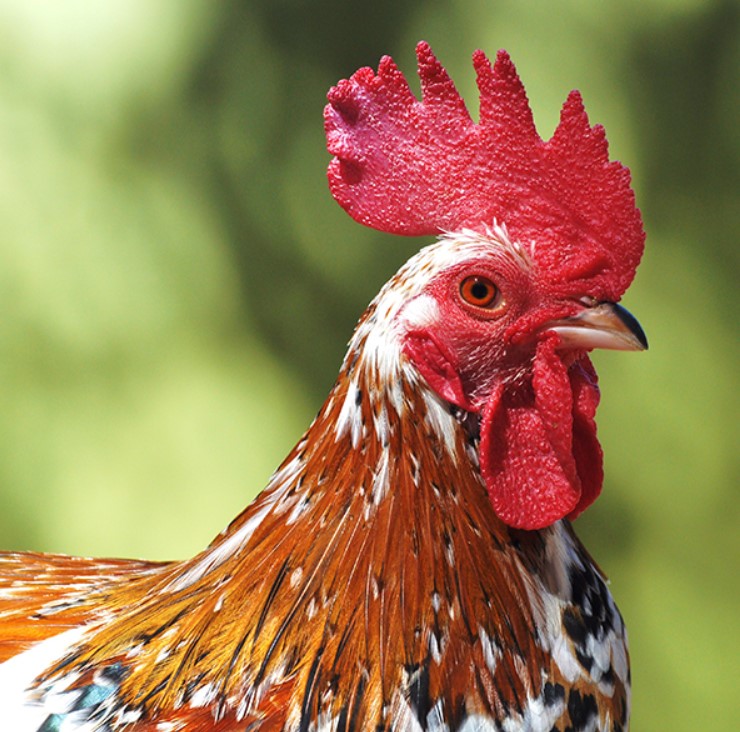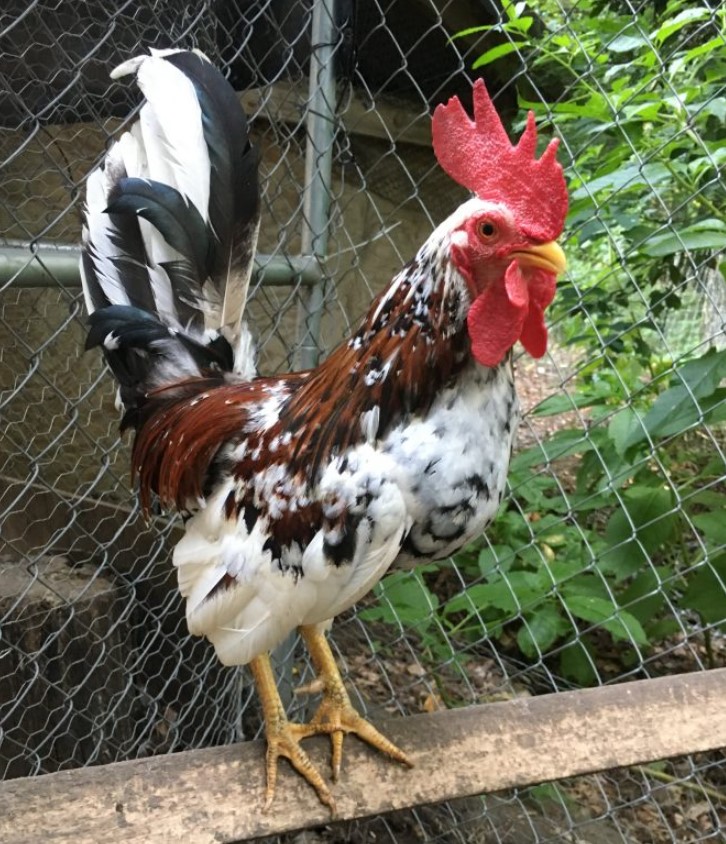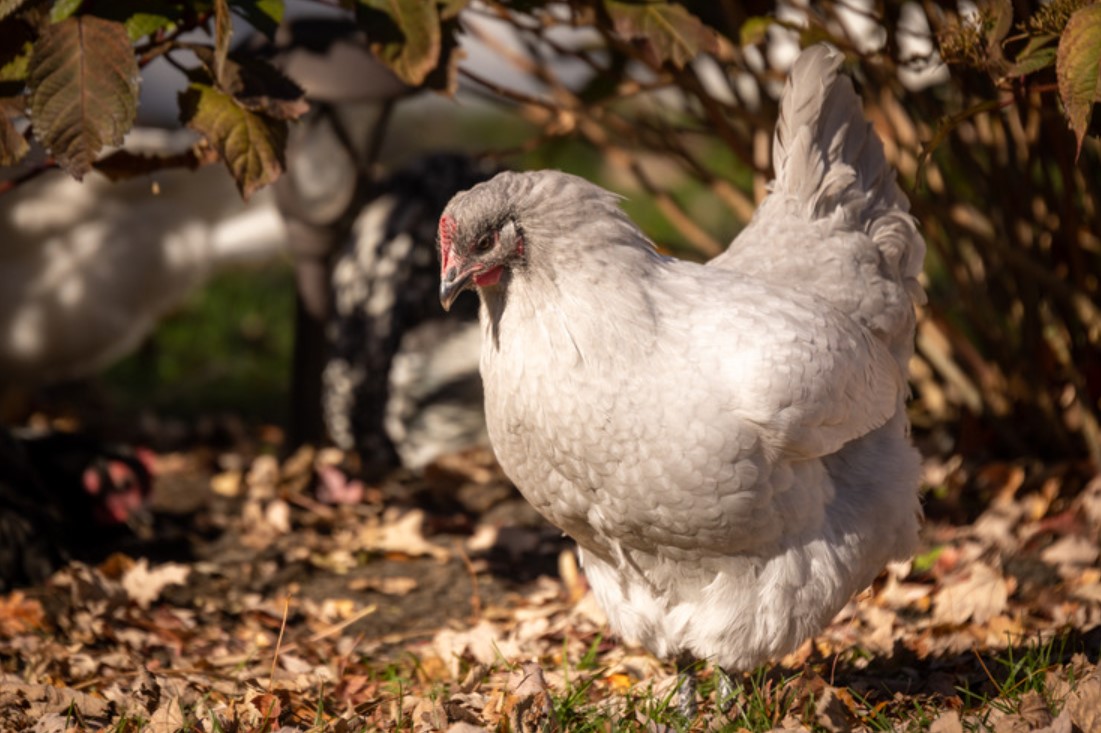
Let's learn more about chickens
The chicken (Gallus domesticus) is a large and round short-winged bird, domesticated from the red junglefowl of Southeast Asia around 8,000 years ago. Most chickens are raised for food, providing meat and eggs; others are kept as pets or for cockfighting.
Chickens are common and widespread domestic animals, with a total population of 26.5 billion as of 2023, and an annual production of more than 50 billion birds. A hen bred for laying can produce over 300 eggs per year. There are numerous cultural references to chickens in folklore, religion, and literature.

Poultry farming
Chickens are common and widespread domestic animals, with a total population of 23.7 billion as of 2018. More than 50 billion chickens are reared annually as a source of meat and eggs.In the United States alone, more than 8 billion chickens are slaughtered each year for meat, and more than 300 million chickens are reared for egg production. The vast majority of poultry is raised in factory farms. According to the Worldwatch Institute, 74% of the world's poultry meat and 68% of eggs are produced this way. An alternative to intensive poultry farming is free-range farming. Friction between these two main methods has led to long-term issues of ethical consumerism.
Opponents of intensive farming argue that it harms the environment, creates human health risks and is inhumane towards sentient animals. Advocates of intensive farming say that their efficient systems save land and food resources owing to increased productivity, and that the animals are looked after in a controlled environment. Chickens farmed for meat are called broilers. Broiler breeds typically take less than six weeks to reach slaughter size,some weeks longer for free range and organic broilers.
Chickens farmed primarily for eggs are called layer hens. The UK alone consumes more than 34 million eggs per day. Hens of some breeds can produce over 300 eggs per year; the highest authenticated rate of egg laying is 371 eggs in 364 days. After 12 months of laying, the commercial hen's egg-laying ability declines to the point where the flock is commercially unviable. Hens, particularly from battery cage systems, are sometimes infirm or have lost a significant amount of their feathers, and their life expectancy has been reduced from around seven years to less than two years. In the UK and Europe, laying hens are then slaughtered and used in processed foods, or sold as 'soup hens'.
In some other countries, flocks are sometimes force moulted rather than being slaughtered to re-invigorate egg-laying. This involves complete withdrawal of food (and sometimes water) for 7–14 days or sufficiently long to cause a body weight loss of 25 to 35%, or up to 28 days under experimental conditions. This stimulates the hen to lose her feathers but also re-invigorates egg-production. Some flocks may be force-moulted several times. In 2003, more than 75% of all flocks were moulted in the US.


great for biodiversity
Chickens are omnivores by nature and enjoy chasing down plant-destroying insects like grasshoppers, grubs, beetles, and larvae, ridding an area of potential pests in a very short time. Many of our organic farmers rely on their chickens as a natural “insecticide” for their flower and vegetable gardens.
- Chickens eat insects like grasshoppers, beetles, and larvae, which can help control pests in gardens.
- They can also eat fallen fruit and green leaves.
- Chickens can help reduce organic waste by eating vegetable matter and table waste.
- Their manure is high in nitrogen and can be used as fertilizer to rejuvenate soil.
- Chickens' manure is free of diseases and bacteria found in the manure of meat-consuming animals.
- When mixed with organic materials like leaves and produce clippings, it can be broken down into a usable fertilizer.
- Producing eggs at home reduces emissions from shipping, refrigeration, and transport.
- Free-range chicken farming requires less land and resources, and the waste produced is less likely to cause pollution.



Chickens
In science
Chickens have long been used as model organisms to study developing embryos. Large numbers of embryos can be provided commercially; fertilized eggs can easily be opened and used to observe the developing embryo. Equally important, embryologists can carry out experiments on such embryos, close the egg again and study the effects later in development. For instance, many important discoveries in limb development have been made using chicken embryos, such as the discovery of the apical ectodermal ridge and the zone of polarizing activity.


The chicken was the first bird species to have its genome sequenced. At 1.21 Gb, the chicken genome is similarly sized compared to other birds, but smaller than nearly all mammals: the human genome is 3.2 Gb. The final gene set contained 26,640 genes (including noncoding genes and pseudogenes), with a total of 19,119 protein-coding genes, a similar number to the human genome. In 2006, scientists researching the ancestry of birds switched on a chicken recessive gene, talpid2, and found that the embryo jaws initiated formation of teeth, like those found in ancient bird fossils.

History of breeding the finest show chickens
The first poultry show in the United Kingdom was in 1845 in London. The exhibition of poultry was promoted as an alternative to cock fighting in the United Kingdom following the banning of such activities in 1849. The first poultry standard in the world was produced in 1865, the British Poultry Standard. The height of the poultry showing in the United Kingdom was during the late 19th and early 20th century, when The Crystal Palace Poultry Show were held at The Crystal Palace, the largest attracting 10,533 filled cages, the actual number of birds unknown as many were pairs. Charles Darwin regularly attended and showed pigeons at these from 1857, and Queen Victoria exhibited her Cochins in 1846 at the Royal Dublin Show.The Crystal Palace Great Poultry Shows continued to run with great success until the Crystal Palace burnt down.
The first poultry show in North America was held on 15-16 November, 1849, in Quincy Market, Boston, surpassing expectations to receive over 1400 entries however it proved a debacle as no poultry standard existed and judging was cancelled as there was no way to decide what was a purebred. A poultry association was organised afterwards and another show attempted the next year, which attracted 12,000 birds. Overcrowding led to judging being cancelled again.
In 1854 P. T. Barnum staged a National Poultry Show at his Barnum's American Museum, which the guidelines of are unknown. It wasn't until 1874 that the American Standard of Perfection were adopted by the recently formed American Poultry Association, creating the first poultry standard in North America.


Poultry shows are generally organised by a poultry club. Many of these are accredited by a national body, such as the American Poultry Association or the Poultry Club of Great Britain while others, such as Australian poultry clubs are only managed on a state level. Birds exhibited at poultry shows are judged to the local standard, a compiled manual that describe the ideal form of a poultry breed.
Picking show chicken breeds
Picking show chicken breeds for your first foray into the world of fancy chickens can be as daunting as trying to understand genetics. But with a few simple pointers, you can be on your way to success.
First and foremost, don’t pigeon hole yourself by chasing the ideal breed. Finding good breeding stock can be difficult enough, being overly picky can make the difference between you wanting to get into “the fancy” and actually doing it. I suggest picking a general body type, going to a good-sized poultry show and seeing what piques your interest in the for sale cages. Being flexible is key, especially for your first time out.


EASY KEEPERS
Especially for someone just getting into it, I highly suggest picking a show chicken breeds that are easy to keep and easy to show. There are many breeds of show chickens out there that are simply a chore to prep for the show or require certain things to conform to breed standard that will turn people off from raising them. I generally suggest beginners start with something small, clean legged, monochrome and devoid of undue complications.
Orpingtons are often recommended for beginners due to being docile and easy to handle.
BANTAM
Bantam birds are much smaller than your typical backyard bird and many standard sized breeds have miniature counterparts in the bantam world. The bonus of keeping bantams for showing is that, well … they’re small. It’s easier to transport, handle, wash, and manage pint-sized chickens. They eat less feed which saves money and they’re adorable too. It simply makes life easier when your chicken fits the palm of your hand.
Bantams come in all kinds of colors


CLEAN LEGGED
I suggest beginners start with a clean-legged bird, which means they don’t have feathers on their legs. A feather-legged breed like Cochin chickens and Brahma chickens are fun and appealing, but keeping their boots clean is a nightmare. Look for a clean-legged breed, like Orpington chickens, Rose Combs or Leghorns.
Brahma chickens
MONOCHROME
There are some beautiful color patterns out there to pick from. With all these gorgeous options, why would I tell someone to pick a boring monochrome variety for their first show chickens? When you’re developing a line of birds for competition, you first work on your body type, then feather coloring, then you develop the color pattern. If you have a monochrome bird, you’ve cut out the third step. Cutting out that last step will save you lots of time and frustration. In the future, feel free to challenge yourself with a patterned bird, but for the first flock, keep it simple.
Clean legged monochrome chickens are the easiest for beginners in show.

INHERENT COMPLICATIONS
What I consider a deal breaker in a starter breed is complications that are inherent to the breed or breed standard. For instance, White Crested Black Polish are fun, quirky, and silly, but unless you’re willing to pluck their crest, you will have a hard time winning. These birds are notorious for growing too much black feathering in their white crest and these extra black feathers must be plucked until they grow back white. It’s a lot like tweezing your eyebrows, but not everyone is willing to do it.

Another deal-breaking complication is the Old English breed. The bird in itself is a fantastic bird, but the breed standard requires cocks to be dubbed, which effectively means their combs and wattles are trimmed off. This obviously does not sit well with many people.
Exceptionally fluffy chickens, like the Cochin, have a bad habit of making an absolute mess of their vent area. Because there is so much fluff at the “business end” of the bird, it has a habit of soiling itself. Cochins are also known for having low fertility rates because the fluff gets in the way.
Some complications are invisible, such as lethal genes. Araucana chickens are a terribly complicated breed to master since genetics is a crucial topic you need to understand. When breeding two tufted birds, about 25 percent of the offspring will never hatch, dying mid-way through incubation. This is a frustrating reality of that breed.
Before you buy into a breed, ask people who know the breed and find out if they have any peculiar needs you should know about.


bE OPEN MINDED AND LEARN!
BOOKS TO HELP YOU EXPLORE
Books are a great resource and the internet has lots of information, but when it comes to learning about show chicken breeds, it’s best to go to the source. Talk to breeders that have been doing this for years. Nine times out of 10, as soon as you show genuine interest in what they do, the floodgates will open. If you’re wise enough to clam up and soak in the torrent of information they’ll bestow upon you, you’ll have a genuinely solid understanding of the breed you’re researching. Go out there, window shop a bit and pick the brains of the experienced breeders.






